|
|
|
|
|
|
|
Achi-Kochi Japan
Showing many places to visit and foods to eat in Japan
|
|
|
|
|
|
|
|
|
|
|
|
|
Japan
> Kinki region
> Kyoto City
|
|
|
|
|
|
|
Kyoto City
Kinki ( Achi-Kochi Japan )
|
|
|
|
|
|
|
|
|
|
|
|
|
( "Achi-Kochi" in Japanese means "Here and there" in English. )
Kyoto City
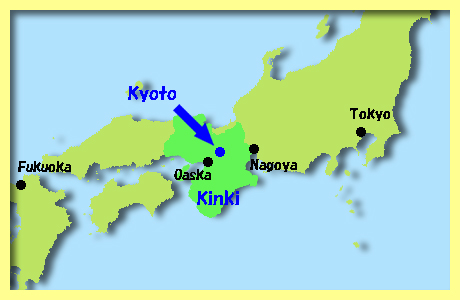
In A.D.794, the new capital city of Japan was constructed and named "Heian-kyo" ( ==> A History of Japan vol.1 Formation of Japan ). Heian-kyo ( now Kyoto City - above ) had been the capital city even after Kamakura Shogunate was established in Kamakura.
In A.D.1868 Tokugawa Shogunate was overthrown and Meiji Period started. Then Edo became the capital city and was named "Tokyo". However many historic structures remain in Kyoto, such as Imperial Palaces, Imperial Villa, old temples and shrines.
During World War II, many historic buildings were destroyed in many cities in Japan, such as Nagoya-jo Castle by air raids and Hiroshima-jo Castle by the first atomic bombing. Also Kyoto City was attacked by U.S. aircrafts several times. However most of its historic structures survived intact in Kyoto, where so many tourists visit.
|
|
Kyoto Gosho ( Kyoto Imperial Palace )
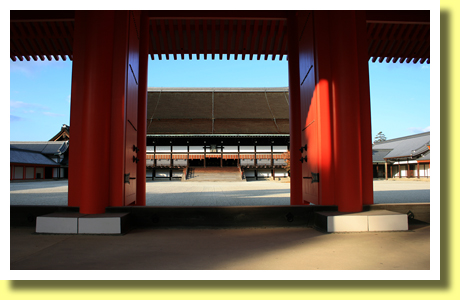
In Heian-kyo, the Imperial Palace was constructed and burnt down several times. The present structures of Kyoto Gosho ( Kyoto Imperial Palace ), reconstructed in A.D.1855, remain in Kyoto even after the Meiji Restoration when Edo-jo Castle became Kokyo ( the Imperial Palace ) in Tokyo.
Even in the 20th century Shishin-den ( above ), one of the main buildings in Kyoto Gosho, had been the important ceremonial hall, where Emperor Taisho and Emperor Showa were enthroned.
Even now Kyoto Gosho is officially the Emperor's residence in Kyoto and managed by the Imperial Household Agency. Though access to Kyoto Gosho is strictly limited, visitors could join guided tours to walk around the Palace.
|
|
Kinkaku-ji Temple ( Temple of Golden Pavilion )
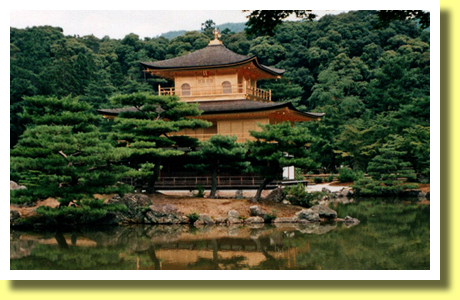
Kinkaku-ji Temple ( Temple of Golden Pavilion, officially "Rokuon-ji" Temple ) is included in a UNESCO World Heritage Site and one of the most famous and popular temples in Japan. The second and third stories of the three-story structure are covered with gold leaf as above.
In A.D.1397 Yoshimitsu Ashikaga, the third shogun of Muromachi Shogunate, purchased the site of Saion-ji Temple where he started the construction of his retirement villa. After he died in A.D.1408, his villa was transformed into Kinkaku-ji Temple.
In the late 16th century, the fires of the Onin War destroyed buildings of the temple but the Golden Pavilion, which was burnt down in A.D.1950 by a young monk who was sick mentally. It was in A.D.1955 when the Golden Pavilion was reconstructed.
|
|
Fushimi Inari Taisha Shrine
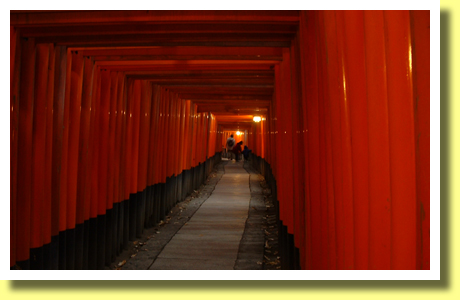
Inari is the God of rice farming, which has been and is one of the most important industries in Japan for a few thousand years. So there are tens of thousands of Inari shrines throughout the country. Fushimi Inari Taisha, located in Fushimi-ku, Kyoto City, is the head of Inari shrines. Also Fushimi Inari Taisha is famous for thousands of torii gates ( above ). So many tourists visit the Shrine to walk through the torii gates.
While it is said that Fushimi Inari Taisha Shrine was founded in the 8th century, the present buildings of the Shrine were constructed in A.D.1499. Also there in the site of the Shrine are many statues of foxes, which are thought to be the messengers of Inari.
|
|
Yasaka-jinja Shrine

Yasaka-jinja Shrine, which used to be called "Gion-jinja Shrine", is located in Gion District, Kyoto City. It is said that the Shrine was founded in A.D.656. There in the site of the Shrine are a few dozens of structures, among which the main hall was built in A.D.1654 and is one of designated National Treasures of Japan. Above photo shows Mai-dono ( stage hall - left ) and Hon-den ( main hall - right ) of the Shrine.
There is Maruyama Koen ( Maruyama Park ) next to Yasaka-jinja Shrine. Maruyama Koen is famous for lots of cherry trees. So in the season of Hanami ( Sakura Viewing ), lots of people visit Maruyama Koen and Yasaka-jinja Shrine.
|
|
Tenryu-ji Temple
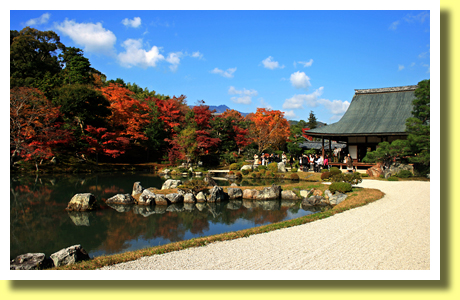
Tenryu-ji Temple was founded in A.D.1339 by Takauji Ashikaga who established Muromachi Shogunate in A.D.1336. The first head priest of the temple was Soseki Muso, who was also famous for garden designing. There in the site of Tenryu-ji Temple remain the garden ( above ) designed by Muso Soseki.
The structures of the temple had been burnt down repeatedly. So most of the buildings were reconstructed in the 19th-20th century. However the garden, designed by Muso Soseki, remains almost as was constructed in the 14th century. Many tourists visit the temple and walk around the garden especially in the season of autumun tints. Tenryu-ji Temple and its garden are included in a UNESCO World Heritage Site.
|
|
Daikaku-ji Temple

The retired Emperor Saga constructed an Imperial Villa in A.D.833 in Sagano Disctrict in the west of Kyoto. He died in A.D.842 and his Villa was transformed into Daikaku-ji Temple in A.D.876 by his daughter. After the buildings of the temple were burnt down in fires of war in the 14th century, some structures were moved to the site of the temple from the Imperial Palace. The above photo shows the inside of Shoshin-den, which is one of the structures built in the 16th century and is one of designated Important Cultural Properties of Japan.
Next to Daikaku-ji Temple, there remains the Osawa Pond, which was constucted by the retired Emperor Saga. The artificial pond, surrounded by garndes, are popular among tourists. Lots of people visit Daikaku-ji Temple and Osawa Pond, especially to enjoy viewing sakura ( cherry blossoms ) in spring and red leaves in autumn.
|
|
Adashino Nenbutsu-ji Temple
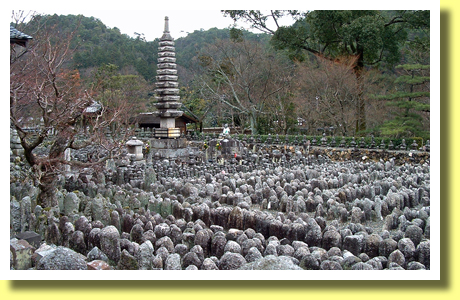
Adashino Nenbutsu-ji Temple is famous for more than 8,000 Buddhist statues ( above ). It is said that the temple was founded in A.D.811 by Kukai ( or Kobo Daishi ), who is famous for Shikoku Henro Pilgrimage. In the 13th century, Honen reorganized the temple as Adashino Nenbutsu-ji.
Kukai collected abandoned bodies of the dead, for whom a thousand of Buddhist statues were placed. In addition, thousands of statued were collected and placed here in the temple in A.D.1903. The main hall of the temple was built in A.D.1712.
|
|
Arashiyama and Sagano
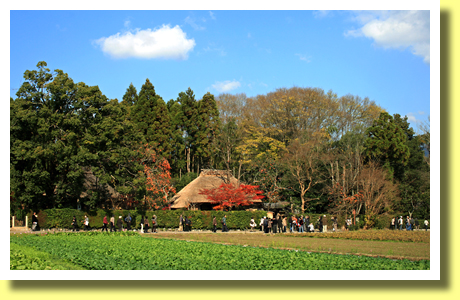
Arashiyama and Sagano distrct is located in the west of Kyoto. Since Heian-kyo capital city was constructed in the 8th century, Arashiyama and Sagano had been one of favourite districts of the nobles. Above photo shows a part of Sagano and Rakushi-sha, a hut of famous Haiku poet.
There in the rural district are dozens of historic and famous sites including Tenryu-ji Temple, No-no-miya jinja Shrine, Gio-ji Temple, Nison-in Temple, Daikaku-ji Temple, Osawa Pond, Togetsu-kyo Bridge, Jojakko-ji Temple and Adashino Nenbutsu-ji Temple and many more. Many tourists visit Arashiyama and Sagano district to walk around popular sites including bamboo groves.
|
|
Ryoan-ji Temple
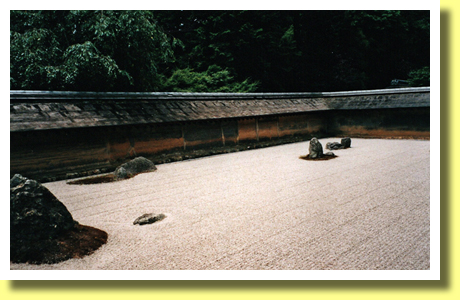
Ryoan-ji Temple is included in a UNESCO World Heritage Site and famous for its kare-sansui ( dry landscape garden or rock garden - above ). There is the hojo, the residence of the head priest, beside the garden. Some more gardens, including a water garden, are located around the hojo.
Here used to be a temple founded in the 11th century by Fujiwara clan, an aristocrat family. In A.D.1450 Katsumoto Hosokawa, a influential warlord, purchased the site of the temple, where he founded Ryoan-ji Temple, which was damaged in Onin War in the mid-15th century. In A.D.1488, Masamoto Hosokawa, a son of Katsumoto Hosokawa rehabilitated Ryoan-ji Temple.
|
|
Kodai-ji Temple
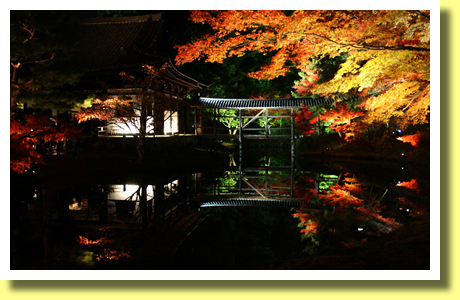
There are some temples and shrines where sakura ( cherry blossoms ) are lit up in spring and red leaves in autumn. Kodai-ji Temple is one of such sites and above photo shows red leaves lit up and Kaisan-do ( Founder's Hall ) surrounded by a pond garden. It is said that the pond garden was designed by Enshu Kobori, a famous landscape garden designer. Kaisan-do was built in A.D.1605.
Kodai-ji Temple was founded in A.D.1606 by Kita-no-Mandokoro ( or Nene ) after her husband, Hideyoshi Toyotomi, died in A.D.1598. Her husband unified Japan in A.D.1590. The Construction of the temple was financed by Ieyasu Tokugawa, who established Tokugawa Shogunate in A.D.1603.
In the site of Kodai-ji Temple remain not only Kaisan-do but also Otama-ya Sanctuary, Shiguretei Teahouse, Kasatei Teahouse, Omote-mon Gate and Kangetsu-tei ( Moon Viewing Pavilion ), all of which are designated Important Properties of Japan.
|
|
Kiyomizu-dera Temple
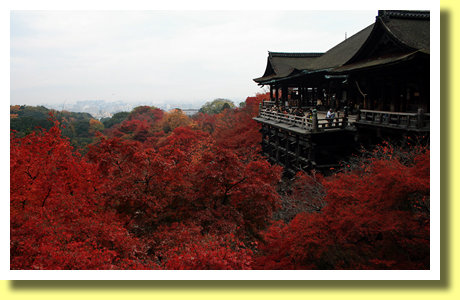
There in the east of Kyoto is a famous waterfall named "Otowa-no-Taki", which is famous for pure waters. A temple, founded near the waterfall in A.D.780, was named "Kiyomizu-dera" after the waterfall. "Kiyomizu" in Japanese means "pure waters". Now Kiyomizu-dera Temple is included in a UNESCO World Heritage Site.
The temple is so famous for a wooden veranda which juts out, supported by lots of pillars. Kiyomizu-dera is one of the most popular temples in Kyoto. Especially in autumn, so many people visit the temple to enjoy viewing autumn tints from the veranda as above.
There in the site of the temple are not only the veranda, but also main hall, Oku-no-in hall, three-story pagoda, Jishu-jinja Shrine, Otowa-no-Taki waterfall and some more structures. Most of the present structures of the temple were constructed by Iemitsu Tokugawa, the third shogun of Tokugawa Shogunate. He was famous for the renovation of Nikko Toshogu Shrine.
|
|
Ohara
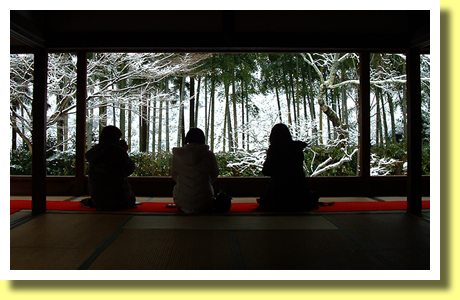
Ohara is a rural village surrounded by mountains, located in the north of Kyoto City. Sanzen-in is the most famous temple in Ohara, where are some more small but attractive temples such as Hosen-in, in a building of which visitors could enjoy viewing the garden as above.
Also tourists would enjoy walking around Ohara village, where a few thousand people live, and visiting some more temples including famous Sanzen-in. Many tourists visit Ohara in spring and/or in autumn. It is also recommended to visit there in winter. Temples and gardens in snow are breathtakingly beautiful though it could be freezing.
|
|
Katsura Rikyu ( Katsura Imperial Villa )

Katsura Rikyu ( Katsura Imperial Villa ), located in the west of Kyoto City, was constructed in the 17th century by two imperial princes ( Toshihito Shinno and his son, Toshitada Shinno ) and completed in A.D.1645. There remains one of the most beautiful Japanese gardens ( above ) as well as traditional Japanese buildings.
Katsura Rikyu is managed by The Imperial Household Agency as well as Kyoto Gosho and Shugakuin Rikyu are. However tourists could join the guided tours to walk around the garden surrounding Katsura Rikyu ( Katsura Imperial Villa ).
|
|
Nishiki Ichiba ( Nishiki Market )
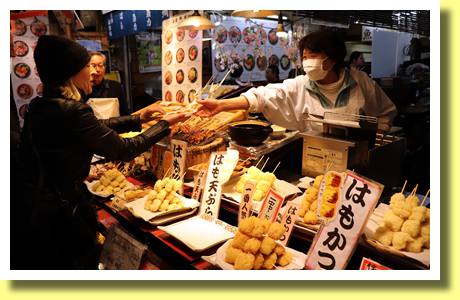
Nishiki Ichiba ( Nishiki Market ) is one of the sites popular among tourists. It is a market located on narrow Nishiki-koji street between Takakura street and Teramachi street. There in the market are more than 120 shops ( above ) offering various kinds of foods including seafoods, vegetables, pickles, sweets, fruits and many more. Also there are some restaurants in the market. Sometimes they call Nishiki Ichiba "the Kichen of Kyoto".
It is said that seafoods were sold here in the 8th century. It could be the origin of Nishiki Ichiba. One of many shops run in Nishiki Ichiba was established in the 16th century. In A.D.1716 Jakuchu Ito was borne into a merchant family who ran a greengrocey in Nishiki Ichiba. Jakuchu Ito himself ran the greengrocery and became a famous painter.
|
|
Washoku ( Japanese Cuisine )
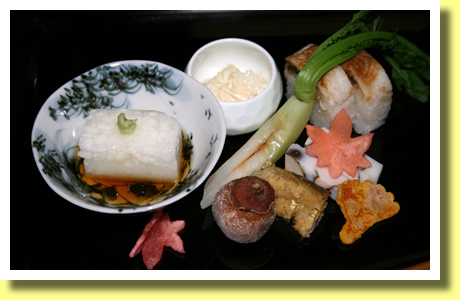
There in Kyoto are many restaurants and ryokan ( Japanese style accommodation ) offering Washoku ( Japanese foods ) served beautifully as above. Kyoto has been and is the most important platform for the development of Japanese culture and is one of the best cities to experience Japanese Cuisine.
|
Copyright (c) 2021 Achi-Kochi Zanmai Co., Ltd.
|